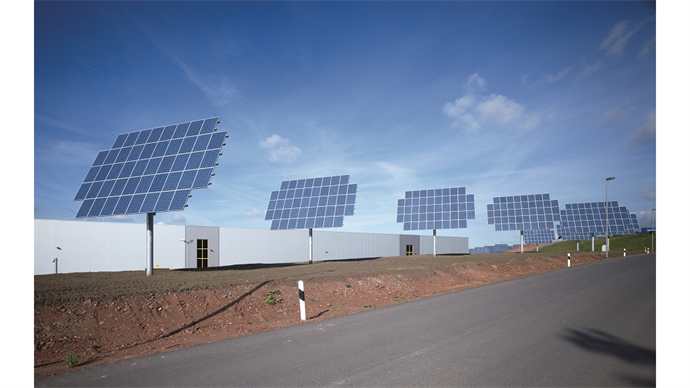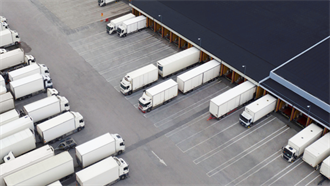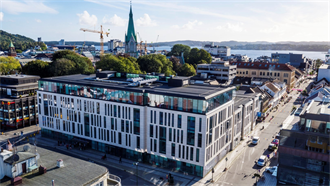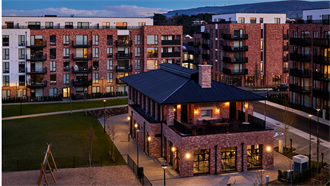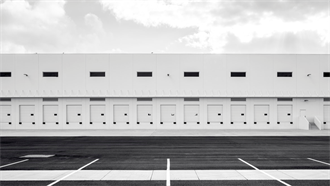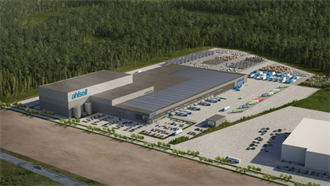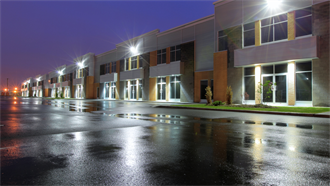Up to now, sustainability has hardly been an issue when acquiring or leasing a logistics property. That is now changing, says Stephan Riechers, head of investment management logistics at Union Investment Real Estate.
The latest report from the Intergovernmental Panel on Climate Change pulled no punches: if we don’t protect the climate, there will be no future. And time is running out. To achieve the ambitious goals of the Paris Climate Agreement, member states are likely to take even stronger action over the coming years, especially with regard to CO2 emissions.
Furthermore, that action could be tied to sanctions if property holders fail to develop their portfolios in accordance with the relevant pathway. Regulations to this effect have already been adopted in some countries.
Supply chains getting greener
At the same time, more and more big companies, including investors, tenants and customers of many logistics service providers, are pushing for a stronger commitment to combating climate change because they want or need to improve their sustainability credentials. Supply chains will get greener overall, without a doubt. Anyone who misses the boat risks being left with ‘stranded’ properties for which there is no demand and no market.
Logistics properties used to be one thing above all: functional. Tougher climate-related legislation, surging energy costs and increasing calls for decarbonisation from tenants, their customers and from investors are now bringing sustainability into sharp focus in the warehousing segment. According to a study by analysis firm Bulwiengesa, the proportion of logistics properties certified as sustainable is rising steadily. It’s a simple calculation: long-term value retention and stable income will no longer be possible in the future without sustainable adaptation.
At Union Investment, sustainability has been an important and strategic commitment within the real estate segment for some 15 years. In 2018, the Hamburg-based real estate investment manager set itself the target of making its global property portfolio carbon neutral by 2050 via its manage-to-green strategy.
As part of each acquisition process, the ESG aspects of the property or development are thus analysed using the company’s own Sustainable Investment Check (SI Check) – an evaluation system that was introduced back in 2009. The check is repeated annually for existing holdings. This assessment allows a building’s strengths and weaknesses to be recognised at an early stage along with identifying the short or medium-term measures required to make it more sustainable.
The evaluation system covers seven categories in total, including data related to building structure, in-use measures and user comfort. At the same time, target values are defined which a property must achieve in future in order to reduce greenhouse gas emissions to net zero by 2050. The results of the SI Check, together with up-to-date energy consumption data and CO2 emissions, are documented and managed using Union Investment’s ImmoSustain software solution. All relevant sustainability data can therefore be viewed at property and fund level. This provides a valuable basis for discussion, as improvements can often be achieved by implementing relatively simple measures.
The logistics facility of the future
Buildings are obviously a key factor as the logistics sector transitions to sustainability. But what makes a logistics facility sustainable? A property with one of the established sustainability certificates is not necessarily energy efficient, nor is it automatically on track to hit zero carbon by 2050. As part of the EU Action Plan, the Taxonomy Regulation provides an initial set of rules here, currently primarily around ecological objectives. When it comes to real estate investment – whether acquiring a new property or investing in the existing portfolio – the focus thus needs to be on energy efficiency and on greenhouse gas emissions over the entire lifecycle. The use of recyclable materials is also becoming increasingly important in the context of remodelling and demolition.
The logistics property of the future will above all be efficient, and not just in terms of operation. Energy consumption in warehouses is relatively low compared to other property types. It is thus particularly important for the logistics side to be planned, built and managed efficiently. Pick-by-voice and stacker control systems, for example, can be deployed to achieve lower error rates, fewer empty journeys, faster picking and greater productivity – which all contributes to sustainability.
Issues here range from efficient lighting to insulation and heating, modern warehouse systems, charging points for electric vehicles and on-site energy production via solar panels and combined heat and power plants. Their large, flat roofs make logistics facilities ideal for solar installations, but investors and owners face significant obstacles around tax and regulation if they want to operate the panels themselves, rather than letting the tenant do it. Without alternative energy concepts, it is almost impossible for a logistics facility to achieve zero carbon, so policy makers need to address this issue.
That is particularly important because there is also the user-investor dilemma to consider, whereby the owner/landlord of a property makes the investments, but the tenant/user benefits from them. Energy efficiency investments are often not pursued because although tenants would enjoy lower utility costs, landlords would be unable to generate a return on their investment in the long term.
Handling supply-side issues
Demand for logistics properties is high, but supply is limited. As such, investment in development projects has been on the rise for several years now, partly because it only takes an average of one to two years to construct a warehouse. However, the EU Taxonomy criteria must be taken into account for logistics buildings from 2021 onwards, assuming investors and developers want to stay in the green race. For many logistics projects, implementing the taxonomy is challenging because facilities are frequently constructed on well-connected greenfield sites away from cities.
One of the environmental targets set out in the Taxonomy Regulation is the protection of ecosystems and biodiversity. If the land to be built on has moderate soil fertility or better, development falls under the “Do no significant harm” rule and is not taxonomy compliant. No compensation measures are possible and there is no retrospective remedy either. Regardless of how energy efficient the new build is, it will never be considered taxonomy compliant. Accordingly, building on or investing in greenfield sites will become less attractive or will at least not count towards sustainability. A soil survey is definitely essential ahead of any investment.
Brownfield sites, by contrast, become more attractive because no permeable land is lost and the technical infrastructure is mostly already in place, along with transport links to what are typically urban surroundings. On the other hand, there is often a remediation requirement and land prices are generally higher. Going forward, it will be necessary to weigh up the pros and cons more carefully.
The social taxonomy is likely to be of limited importance for logistics facilities, and indeed for commercial real estate in general, although the specific criteria have yet to be defined. The initial draft mainly deals with affordable housing. Having said that, logistics properties can still meet the ecological criteria and be included as a taxonomy compliant building when calculating the overall taxonomy compliance of a financial product.

